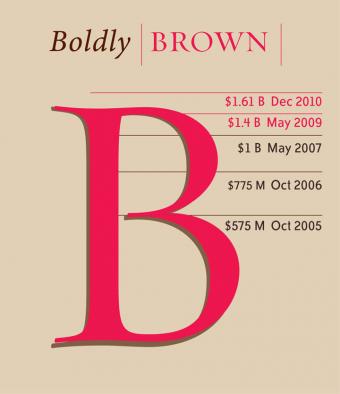PROVIDENCE, R.I. [Brown University] — In messages sent today to alumni, donors, parents, and the campus community, Brown University President Ruth J. Simmons announced the success of the University’s seven-year, $1.4-billion “Boldly Brown” comprehensive campaign.
Launched publicly in October 2005, the campaign reached its original goal in May 2009 and continued to 115 percent of its goal — $1.61 billion — by its formal conclusion on Dec. 31, 2010.
“This is an historic achievement for Brown, one that would not have been possible without your hard work and steadfast commitment to our goals. More than 69,000 alumnae, parents and friends contributed to Boldly Brown,” Simmons wrote to campaign leaders and volunteers. “This University has always been an extraordinary institution, well-supported by our extended community and focused firmly on a goal of academic excellence. Now, with additional course offerings, expanded international exchanges, increased multidisciplinary research opportunities, and the welcome intellectual stimulation derived from additional new colleagues, our outlook is as bright as our aspirations.”
“This campaign is moving Brown forward in ways that were unimaginable 10 years ago,” said Chancellor Thomas Tisch. “As a community we’ve come together to provide support that is enabling us to transform Brown in very fundamental ways.”
The Boldly Brown campaign was carefully aligned with priorities in the University’s Plan for Academic Enrichment. That plan, officially endorsed by the Brown Corporation in February 2004, set the University on a course to develop, among other priorities:
- a larger, better supported faculty;
- expanded undergraduate financial aid;
- new and refurbished academic and research facilities;
- additional investment in graduate education;
- significantly expanded relationships with international institutions;
- more educational and research opportunities abroad for students and faculty;
- a renewal of the historic campus and a plan for its future development; and
- a new home for the Alpert Medical School, the University’s first significant academic development beyond College Hill.
Achievements of the Boldly Brown campaign
- Raised $1.61 billion. The campaign met its original $1.4-billion goal 19 months early — in May 2009 — and raised 15 percent more by Dec. 31, 2010.
- Engaged more than 69,000 donors, including record-setting participation by parents who are not Brown graduates.
- Raised $737 million in new endowment, almost 112 percent of its $660-million endowment goal.
- Raised $273 million for facilities, more than 136 percent of its $200-million facilities goal.
- Raised $573 million in current-use funds, more than 106 percent of its $540-million current-use funds goal, setting a new record for the Brown Annual Fund ($36 million in fiscal year 2010).
The endowment total includes more than $311 million in endowment for undergraduate financial aid and $129 million for 70 new faculty chairs and other endowed positions.
What the Boldly Brown campaign means for Brown
Student life and learning
- Need-blind admission. The University completed its conversion to need-blind admissions with the admission of the Class of 2010 (entered fall 2006).
- With the financial aid budget nearly doubling to $81.5 million in fiscal 2010, Brown has been able to make significant improvements in student aid, establishing the Sidney Frank Scholarships for students with the greatest financial need and no-loan packages for students from families earning less than $100,000, and eliminating the parental contribution for most families earning less than $60,000. Approximately 14 percent of the entering Class 2014 consisted of first-generation students.
- Two new centers now serve student living. The Stephen Robert ’62 Campus Center supports student organizations and social life. J. Walter Wilson Hall, a former biology lab, has been repurposed to house the Office of the Registrar and most other student services offices.
- The Friedman Study Center and the Sciences Center provide flexible space for individual study, group projects, and additional academic programming.
Larger, better-supported faculty
- Brown has increased the overall size of the faculty by approximately 20 percent. In 2003, the number of full-time regular faculty stood at 570; it is now 682.
- Brown’s new academic centers, including the Brown Institute for Brain Science, the Cogut Center for the Humanities, and the Joukowsky Institute for Archaeology and the Ancient World, support and foster a collaborative approach to learning and advancing knowledge.
- There are new opportunities for students and faculty beyond the immediate campus, in the form of partnerships with Draper Labs, the Marine Biological Laboratory, and Trinity Repertory Theatre.
- The University’s research enterprise has grown. Research awards totaled $115.3 million in FY 2002 and grew to $180 million in FY 2010, a 56-percent increase.
Developing the historic campus
Brown has constructed new buildings and renewed other historic buildings to increase academic space and provide more modern equipment and facilities. The new spaces include:
- Sidney Frank Hall for Life Sciences;
- Perry and Marty Granoff Center for the Creative Arts;
- Nelson Fitness Center/Moran Coleman Aquatics Center;
- Cogut Humanities Center (Pembroke Hall);
- Stephen Robert Campus Center (Faunce House);
- Cognitive, Linguistic and Psychological Sciences (Metcalf Laboratories);
- The Joukowsky Institute for Archaeology and the Ancient World (Rhode Island Hall).
Expanding beyond College Hill
- The University has purchased and is developing additional properties in the Jewelry District and on South Main Street for a total of about 620,000 square feet at an investment of $100 million.
- The Warren Alpert Medical School is moving to a new home now being prepared in the Providence Jewelry District.
- The new Institute for Computational and Experimental Research in Mathematics (ICERM) will begin formal operations on the top two floors of the University’s office building at 121 South Main Street.
“This campaign sustained its momentum through some of the worst global economic conditions in memory,” said Steven King, senior vice president for advancement. “Its success speaks to the strength of the University’s ambitious vision and the determination of the Brown community to realize the plan’s potential for a better, bolder Brown.”

